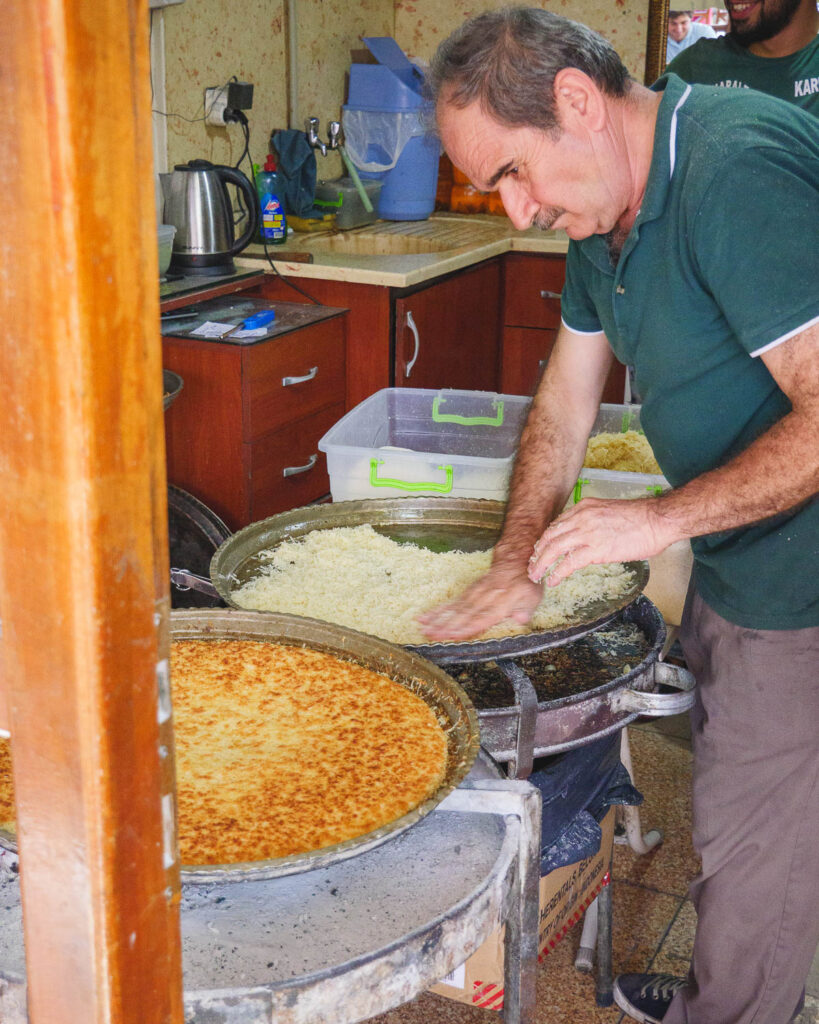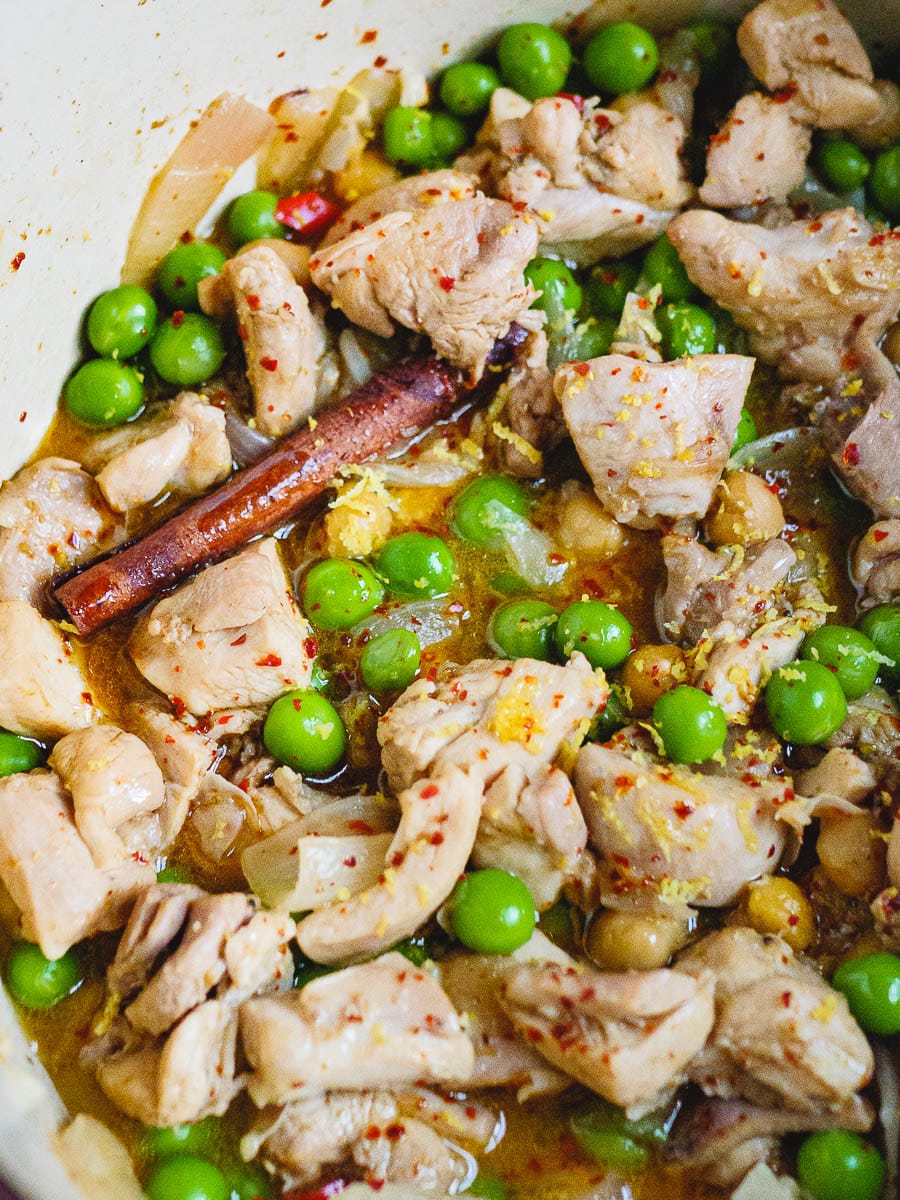Few desserts are as unforgettable as künefe. Loved by all who try it, this is true, yet simple, decadence. It’s best eaten prepared by an expert usta in South Eastern Turkey, but failing that, this home made version comes a close second! Read on for tips on making Turkish künefe at home with the cheeses that are available to you.
Few desserts are as memorable as the first time you eat künefe. When your friend tells you about it, it sounds odd. When it’s in front of you, it looks odd.
And it tastes utterly and unforgettably delicious.
What is künefe?
To understand what künefe is, you simply have to try it. But let me try to explain.
Künefe is the Turkish interpretation of a sweet Levantine cheese pastry. The by far most common version comes with an oozy cheese filling, with a crispy and buttery pastry exterior doused in sugar syrup.
Local versions filled with nuts, clotted cream or other ingredients also still exist.
The pastry is fried, either in individually sized portions (as in the photo above) or in huge trays. These trays are known as tepsi in Turkish.

A little history
Some stories of its origin suggest it’s a treat that used to be served during the fasting month of ramadan.
Most likely, however, künefe is a modernisation of the Arabic dessert qatayif.
Qatayif is a sort of pancake, typically filled with nuts or cheese. In a traditional version, it’s then deep-fried and doused in honey or sugar syrup.
After the technique of making kadayif was developed (more on that below), a similar dessert using kadayif instead of pancakes appeared in a mid-15th century cookbook (yes, in these lands 15th century developments can still be labelled “modernisation”).
Today, künefe is pan fried in plenty of butter. Preferably over coals or wood fire, in individual or huge serving trays.
The cheese used is an unpasteurised local fresh cheese. In Turkey, it simply bears the name of the region from which it originates. Hatay cheese, Antep cheese, Urfa cheese. It is difficult to find this cheese outside of this region, even in Istanbul.
Within Turkey, it’s linked to the countries Levantine areas, primarily Hatay and Gaziantep near the Syrian Aleppo region. This is also kebab-land. If you’re in a Turkish kebab restaurant, chances are you’ll find künefe on its dessert menu.

That said, you’ll find künefe in many places across the Eastern Mediterranean, where it is a much revered dessert. Local versions may differ, though most are a variation of the theme oozy cheese surrounded by sweet pastry.
The difference between künefe and knafeh / kanafe?
Turkish künefe is always made with kadayif. This makes it crispy, with a characteristic golden angelhair spaghetti like exterior.
Arabik knafeh (kanafe) is sometimes made the same way. However, in many places in the Middle East, they use a fine semolina dough in place of the kadayif pastry. This yields a softer dessert. In Istanbul, this is what you’ll typically find in Palestinian knafeh places.
What is kadayif and where to get it
Kadayif is a type of filo pastry, also known as kataifi in Greek. It’s made in a very different way from filo pastry sheets, giving it different properties.
Where filo pastry sheets is made from dought stretched to thin sheets, kadayif is made from a batter dripped onto a hot metal plate. This creates very thin strands of cooked dough, much like a soft angel-hair spaghetti.
Kadayif is used in Turkish, Middle Eastern, Greek and Balkan cooking, primarily for sweet dishes. In addition to künefe, it’s also used to make bird’s nest baklava or individually stuffed kadayif balls, among other things.
Though not traditional, it can also be used in savoury dishes. Famous Turkish food authority and YouTuber Refika Birgül is known for her creative use of kadayif, making schnitzel or savoury börek using kadayif instead of breadcrumbs or regular filo pastry.
It is not to be confused with the confusingly named Turkish dessert ekmek kadayıf (literally “bread kadayif”), which doesn’t actually contain kadayif. Instead, it’s made from sweetened stale bread stuffed with clotted cream.
Outside of this region, it can be hard to find. Mind you, it can be difficult to find even in Turkey unless you have a specialised filo pastry shop nearby. These used to be omnipresent, but are sadly disappearing at a fast rate, replaced by ready-made mass-produced pastry sold by supermarkets.
However, well-stocked international food grocers/Middle Eastern grocers will have kadayif. You’ll find it in the refridgerated or frozen sections.
How to make Turkish künefe
There are no secrets to making a good künefe. If you’re outside of its region of origin, you’ll have to improvise a little, though.
In the Levant, they use a cheese specific to making künefe. It’s soft, fresh, with virtually no salt and with perfectly stringy melting qualities. It may sound like mozzarella to you, but it isn’t.
When visiting Antakya a few years ago, I had a chance to taste the raw cheese. It’s actually fairly crumbly. Like most cheeses from this region, although very mild, it’s got a slightly tangy flavour.
Here’s a true Turkish usta (craftsman) at work at Çınaraltı Yusuf Usta, one of the most renowned künefe places in Antakya, Hatay:



You can substitute any mild, stringy low sodium cheese that is available to you locally. This will often mean mozzarella. In Turkey, dil peyniri is commonly used.
I like to add a small amount of labneh too for that slightly tangy flavour. It’s barely noticeable, but I find it adds a certain je ne sais quoi which takes me just that tiny step closer to the künefes I had in Antakya.
Ingredients at the ready, the rest is fairly straightforward. To make it easier to handle, chop up the kadayif pastry, then mix it with butter. Layer with cheese in a pan and fry on both sides. You can use as small or large a frying pan as you wish. It all depends on how many portions you want to make.
Once cooked, pour over the floral sugar syrup, top with chopped pistachioes and enjoy while the cheese is still stringy! I prefer mine less sweet than what you usually get in Turkey. I therefore only add around 3/4 of the sugar syrup, letting guests help themselves to more if they want it sweeter.

How to serve künefe
You don’t need anything alongside to enjoy künefe to its fullest. Though I have to say, a cup of Turkish coffee or tea wouldn’t go amiss.
It’s often served with clotted cream or ice cream. Keep in mind that the künefe itself is quite heavy with butter and cheese, so this dairy on dairy option is entirely up to you.
The recipe yields a 22-24 cm diameter künefe. That’s enough for a generous four servings.

Künefe – Turkish cheese pastry dessert
Ingredients
- 200 g tel kadayif/kataifi
- 100 g butter, melted, plus extra for the pan
- 125 g firm mozzarella, shredded, or akkawi or another stringy cheese
- 40 g labneh, substitute akkawi if you have it
- 1 handful pistachios (unsalted), finely chopped
Sugar syrup
- 125 g sugar or honey
- 75 ml water
- 3-4 drops rose water, orange blossom water or lemon juice (or to taste)
How I make it
- Make the sugar syrup by adding the sugar and water to a pan. Bring to the boil and leave on a low heat until the sugar has completely dissolved, 4-5 minutes. Take off the heat and add the rose water, orange blossom water or lemon juice. If you enjoy the floral flavours of these waters, you can add a little more. Set aside.
- Cut the kadayif into 1 cm (⅖ in) pieces crosswise. Mix well with the melted butter. It's important that all of the kadayif is buttered. I spend a couple of minutes on this to make sure everything is well mixed and coated.
- Mix the shredded mozzarella with the labneh.
- Butter a medium sized frying pan (22-24 cm/9 in diameter) with plenty of butter. Add half of the buttered kadayif to the pan, pressing it down until even and firm. Spread the cheese mixture evenly across the kadayif, leaving 1 cm (⅖ in) around the perimeter. Distribute the remaining kadayif on top, little by little. Press down again until the top is also fairly firm. Use your fingers to make sure you have nicely rounded edges.
- Set the frying pan over medium heat, then turn down to low as soon as it is warm. Fry until golden on the bottom, 3-5 minutes. Flip and fry until golden on the other side, another 2-4 minutes. I do this by placing a large plate on top of the kadayif, then flipping quickly so the kadayif comes onto the plate, cooked side up. Then slide the kadayif back into the frying pan.
- Take off the heat and add around ¾ of the sugar syrup, or as much as you like. Garnish with chopped pistachios. Serve immediately with the remaining sugar syrup on the side, in case someone likes it extra sweet.















4 responses
Vidar, may I read excerpts from your story on the air in my programs?
Thanks!
Ahmet
Of course!
Fact check: Knafeh is a Palestinian dessert originating from Nablus, Palestine (a simple google search would provide the correct information).
Hi David. My research goes quite a bit deeper than a “simple Google search”, and if you did the same you’d find that what we know about the history of künefe/knafeh is quite a bit more nuanced than that (though knafeh as a dish is no doubt intrinsically linked to Nablus). I’m also quite clearly mainly talking about the Turkish version künefe here, which (as I explain) is both slightly different and came much later than the Arabic desserts, but is nevertheless a very important part of Turkish regional cuisine. Hope that clarifies things!